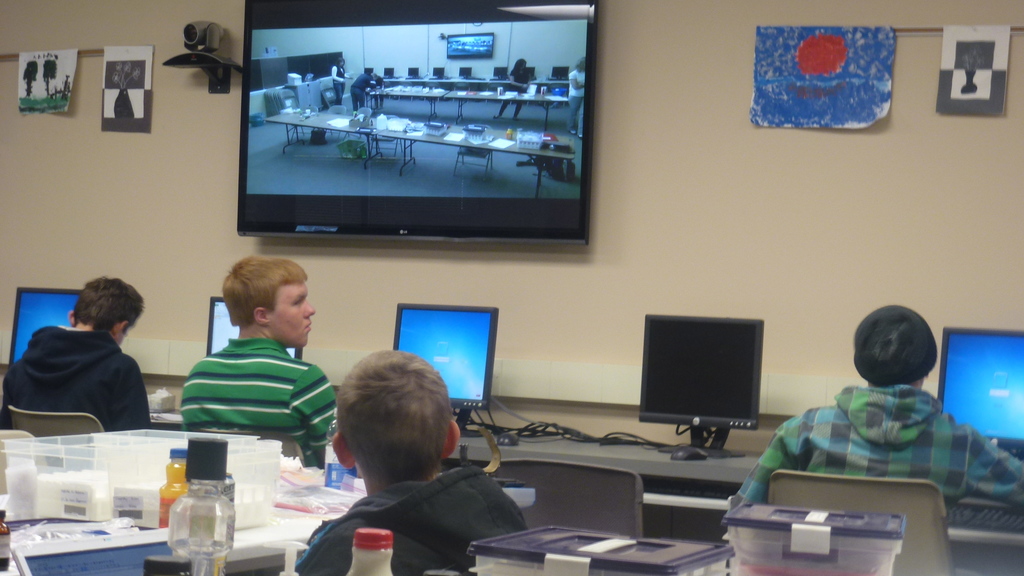EDITOR’S NOTE: Eleven Idaho schools are launching an experiment this fall. They are using $3 million in state grants to try out methods of using technology in the schools. This is the seventh of a series of stories on the grant recipients.
The Idaho Distance Education Academy is already tech-savvy: an online charter school connecting 760 K-12 students statewide.
IDEA is already a strong academic performer, receiving top scores for two successive years in Idaho’s five-star school ratings.
But IDEA believes a $67,754.60 state technology grant will provide a more personalized and more immediate learning experience — even for students taking classes at home and online.
“We don’t want to take our foot off the gas pedal,” director Jason Bransford said. “This how we continue moving forward. We don’t want to stagnate, ever, as a school.”
Bridging ‘the geographical gap’
IDEA’s Boise campus — located in a professional office strip a few blocks from the Boise Towne Centre shopping mall — has some of the conventions of a brick-and-mortar school.

On a recent morning, high school students gathered in a classroom for biology and chemistry lab work. (Students are required to come in for labs, at campuses in Boise, Post Falls or Chubbuck.) But some students seldom have to come in for classwork, and complete almost all their assignments remotely.
The Boise campus has a school library, stocked with books, CDs and videos. But 40 percent of IDEA’s students live in rural areas — too far away to easily come in and use a library.
The overriding goal, IDEA says in its grant application, is to “bridge the geographical gap between our students.” IDEA believes enhanced technology will build a sense of community and boost the academic performance, by giving students better access to curriculum, and improving student communication with teachers and classmates.
The grant takes a multi-faceted approach:
- The school will use some of the money for vendor-supplied textbooks for two years. But this is designed to buy time for faculty to develop their own digital textbooks. The idea behind the teacher-developed textbooks — which rely on publicly available open source material — is to be able to update textbooks in real time, and beef up units where students are struggling.
- Some money will be used to bolster IDEA’s online library. The initial purchases are heavy with non-fiction titles — about a 50-50 split with fiction, says Josh Femreite, IDEA’s technology director. This is consistent with the new Idaho Core Standards, which has a heavy emphasis on research.
- The school will expand the use of its learning management system, known as Moodle, from its high school to all grades. This is, ultimately, the centerpiece of the grant.
A nimbler campus?
IDEA is fully plugged in, but even by school administrators’ admission, there are some lingering glitches. “We feel our current system of instructional delivery and course assessment is disjointed and unevenly accessible by our student body,” IDEA said in its grant application. And despite its five-star ratings, IDEA acknowledges some weaknesses: special needs students have struggled to improve, and some language usage and math grades are low or stagnant.
IDEA sees Moodle as its key for improvement. The system is already in place for ninth- through 12th-graders — allowing high school teachers to see their students’ work, statewide, on a daily basis, and giving students an interactive one-stop shop to access course materials and communicate with teachers and classmates.
Expanding the Moodle system to first- through eighth-graders is designed to give younger students the same kind of interactive experience, but in a simpler, “kid-friendly” format, said Laurie Wolfe, IDEA’s director of curriculum and assessment. The Moodle upgrade comes with up-front costs: for training the rest of the faculty, and for adding a server to accommodate Moodle.
But for a school that already relies on extensive data analysis, expanding the use of Moodle is seen as a next step. If, for example, fifth-graders are having trouble with fractions, teachers can see that right away, Wolfe said. They can also load lesson plans into the system to provide extra help.
By the same token, Moodle allows teachers to tailor lessons for students who are ahead of pace. And while the system shows teachers their students’ strengths and weaknesses, it also helps them learn about their students’ interests and hobbies — and come up with lesson plans that tap into students’ passions.
A scalable model?
Scalability. It’s a recurring theme in the pilot applications. State officials wanted ideas that could be replicated. Winning bidders have gone to considerable length to explain how they believe their ideas can work elsewhere.
That’s even the case with IDEA. The school’s virtual learning environment is supplemented, only occasionally, by learning in a traditional educational setting, but Bransford believes all their approaches can apply in a brick-and-mortar school.
Moodle, and a companion program that allows students to create ePortfolios, are free, and “inherently scalable and financially viable” for any school, according to IDEA’s application. IDEA says other schools will be able to see how their teachers developed virtual textbooks — or simply use the texts themselves. The shift to an online library collection is a potential money-saver.
“When compared with the amount of money spent retrieving lost or overdue books, purchasing new books, and replacing damaged books, the costs seem scalable for any forward-thinking school,” IDEA says in its application.
More stories about the 11 Idaho schools using $3 million in state grants to try out methods of using technology in the schools:
- A schoolwide Chromebooks project at Kuna Middle School.
- A career-oriented laptop pilot at Middleton High School.
- An attempt to reverse achievement gaps at Parma Middle School.
- A writing emphasis at Weiser’s Park Intermediate School.
- A collaborative learning effort at Meridian’s Discovery Elementary School.
- A student-led iPad rollout at McCall-Donnelly High School.
